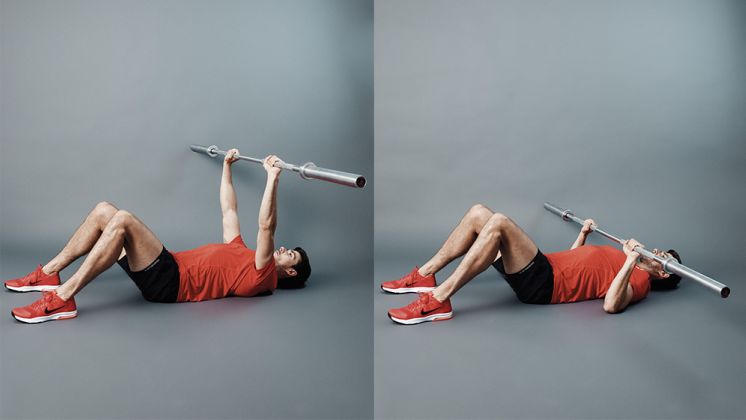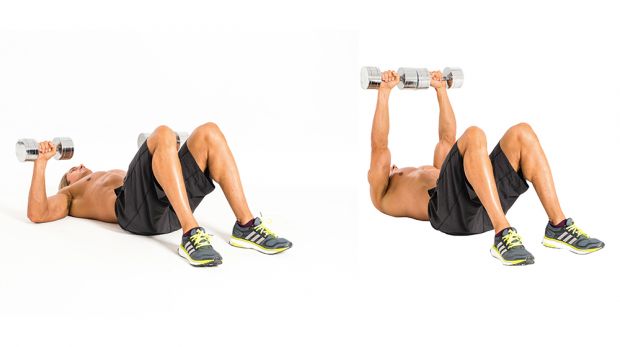How To Do The Floor Press
You don’t need a bench to develop serious upper-body strength

What do you do when the bench press is busy at the gym (or the gym is closed)? Hover nearby, ensuring you don’t lose your turn, or reorder your workout and go and do something else? Or, and this is the best answer, find a free mat and rattle out a set of floor presses?
The floor press is not just a basic version of the bench press to do when there is no bench available. It’s an exercise that has several key differences which merit consideration over its more famous counterpart, especially if you have any kind of shoulder injury.
Since the range of motion in the exercise stops at the floor, you place less strain on your shoulders during the floor press than in the bench press. Lying on the floor also means you don’t get the help from your legs that you do with the bench press, making it more testing on your upper body.
An extra challenge also comes from your arms touching the ground with each rep, which removes the tension from your muscles. This makes the start of each press extra tough as you have to get going again, whereas in the bench press the muscles stay loaded until you re-rack the bar.
The floor press and bench press target the same muscles: chest, shoulders and triceps. You won’t be able to lift as much weight as you can with the bench press, but you can still load up the bar and enjoy strength gains in your upper body.
How To Do The Floor Press
Lie with your back on the floor under your bar and grasp it with an overhand grip and your hands around shoulder-width apart. You can have your legs extended or bent with your feet planted – the former is better for ensuring the lift is powered purely by your upper body.
If you’re under a rack the next step is to take the bar off it and hold it above you, but if you’re lying under a grounded bar you might need to get someone to help you raise it at the start of a set, especially if you’re using heavy weights. Once you’re holding the bar above your chest with your arms outstretched, slowly lower it until your upper arms are touching the ground, then press it back up explosively.
Sign up for workout ideas, training advice, reviews of the latest gear and more.
See related :
- The Best Chest Exercises For All Levels Of Gym-Goer
- The Best Shoulder Exercises For All Levels Of Gym-Goer
- The Best Triceps Exercises For All Levels Of Gym-Goer
Floor Press Variations
Dumbbell floor press

The floor press you’ve come to know and love, but performed with dumbbells instead of a barbell. The benefit of this is that you work each arm unilaterally, so you can’t rely on your stronger side to do the bulk of the work as you can do with a barbell. When lifting the dumbells make sure you press them directly overhead, rather than letting them sway out to the sides or back over your head.
Bridge press
This exercise can be performed with a barbell or dumbbells and adds an extra dimension to your floor press by engaging your glutes, core and hamstrings. As you press the weight overhead, thrust your hips upwards as you would in a glute bridge. Once your arms are fully extended and your hips are up so your body forms a straight line from your knees to your head, pause for a beat, then lower slowly back to the start. You can also opt to hold the bridge for a set of presses, which will maximise the benefits to your core, glutes and hamstrings. Doing so also increases the range of motion of the exercise compared with the classic floor press (especially when using dumbbells), thereby increasing the challenge to your pecs.

Nick Harris-Fry is a journalist who has been covering health and fitness since 2015. Nick is an avid runner, covering 70-110km a week, which gives him ample opportunity to test a wide range of running shoes and running gear. He is also the chief tester for fitness trackers and running watches, treadmills and exercise bikes, and workout headphones.
